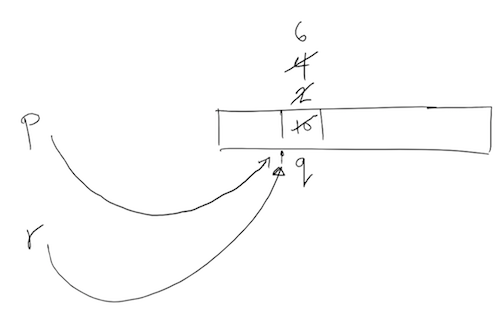| Previous Lecture | Lecture 11 | Next Lecture |
Lecture 11, Tue 08/07
C++ Memory Model, Dynamic Memory
Dynamic Memory Management
- So far, we have been working exclusively with static allocation and stack memory.
- … but there are situations where knowing the exact size BEFORE runtime is limiting.
- It’s not feasible to store dynamically growing / shrinking objects on the stack!
- For dynamically allocating memory during the execution of a program, there’s the free store, or more commonly known as the heap.
Heap
- The heap allows users to manually decide when, how much, and what will be stored in it.
- On the flip side, you must also decide when memory will be deallocated (deleted) in order to reuse it.
- Q: What happens if you forget to delete stuff from the heap?
- Memory leaks! Memory space is finite and eventually your program will crash if unused memory is not being deleted.
- Q: But we can store strings of different sizes on the stack… what’s up with that?
- On the stack, strings are a fixed size containing fields such as the length of the string, and a memory address to the sequence of characters on the heap.
- Note that a memory address and integer size ARE of fixed length (as well as other information the string class may have).
- Behind the scenes, as strings may grow and shrink on the heap, the address that points to the sequence of chars on the heap can change.
- The programmer manages heap memory space manually.
“new” operator
- The primary use for pointers are to access objects that have been dynamically allocated on the heap.
- The result of “new” is a pointer to the object that was allocated on the heap.
Example
int* p = new int(10); // allocate an int on the heap and point p to it
*p = 2; // sets the int value to 2 (without address change)
int& q = *p; // q refers to the value that p points to
q = 4; // change int value to 4
cout << *p << endl; // prints 4
int* r = &q; // make r point to the address that q refers to
*r = 6; // change int value that r points to to 6
cout << *p << endl; // prints 6
cout << q << endl; // prints 6
cout << *r << endl; // prints 6

“delete” operator
- Anytime you use the “new” operator, consider if you need to eventually delete the memory it consumes.
- Otherwise, your program will have memory leaks and eventually crash!
Example of memory leaks
void g(int x) {
int* p = new int(x); // memory leak!
delete p; // remove this and see application size grow!
return;
}
int main() {
for (int i = 0; i < 100000000; i++)
g(i);
}
- since int* p in g() is a local variable, this gets removed from the stack, BUT THE VALUE ON THE HEAP REMAINS.
- Once the variable is removed when the function exits, there is no way to remove this from the heap.
- This is a memory leak!
- Once the variable is removed when the function exits, there is no way to remove this from the heap.
- “delete” is the opposite of new
- “new” creates an object on the heap and returns a pointer to it.
- “delete” takes a pointer and removes the data from the heap.
- “delete p;” doesn’t delete the variable p, it deletes what p points to on the heap!
- “delete” only works for values that exist on the heap.
Dangling Pointers
- After a pointer’s memory is deleted, the pointer itself is still available to use.
- BUT, you should never use a dangling pointer (the behavior of it is undefined).
- And why would you want to use a pointer to something that shouldn’t be there?
Dangling Pointers Example
int g(int x) {
double* p = new double(x);
delete p; // delete value from the heap
return *p; // p is a dangling pointer since heap contents were removed!
// Results in undefined behavior. Shouldn’t do this!
}
Dynamically allocating arrays
- We have been allocating arrays on the stack, but we can also do this on the heap!
- Actually, we SHOULD do this on the heap if our array size is not known during compile time.
- Example of declaring and deleting an array on the heap.
int* arr = new int[10]; // create an array of 10 integers on the heap
delete [] arr; // removes the array from the heap. Note the [] syntax for deleting arrays from the heap.
- Some compilers may have extended functionality to support dynamically allocating arrays using the syntax for statically allocating arrays.
- For example, g++/clang++ allows this, but VisualStudio currently does not:
int x;
cout << "Enter a positive number: ";
cin >> x;
// int intArray[x]; // ERROR IN VisualStudio, NOT g++ / clang++
int* intArray = new int[x]; // LEGAL IN BOTH
for (int i = 0; i < x; i++) {
intArray[i] = i;
cout << intArray[i] << endl;
}
// Note: to delete an array on the heap, use delete [] intArray;
delete [] intArray;